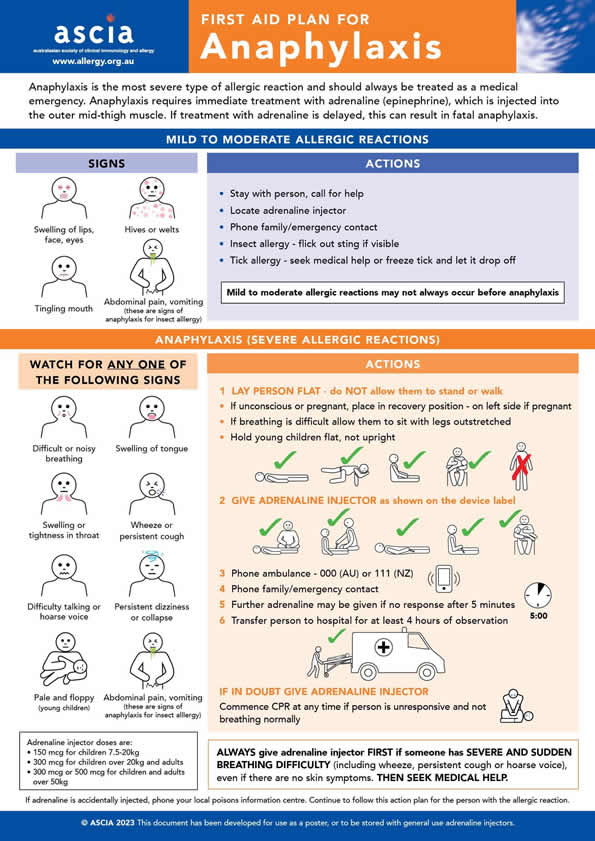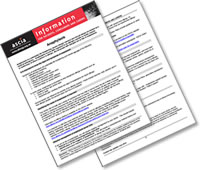Anaphylaxis is a potentially life threatening, severe allergic reaction and should always be treated as a medical emergency. Adrenaline (epinephrine) is the first line treatment for anaphylaxis.
Anaphylaxis occurs after exposure to an allergen (usually to foods, insects or medicines), to which a person is allergic. Not all people with allergies are at risk of anaphylaxis.
 ASCIA PCC Anaphylaxis 202155.41 KB
ASCIA PCC Anaphylaxis 202155.41 KB
It is important to know the signs and symptoms of anaphylaxis
Signs and symptoms of anaphylaxis are potentially life threatening and include any one of the following:
- Difficult or noisy breathing
- Swelling of the tongue
- Swelling or tightness in throat
- Difficulty talking or hoarse voice
- Wheeze or persistent cough
- Persistent dizziness or collapse
- Pale and floppy (in young children)
In some cases, anaphylaxis is preceded by signs and symptoms of mild to moderate allergic reactions, which may include:
- Swelling of face, lips and/or eyes
- Hives or welts
- Abdominal pain and vomiting - these are signs of anaphylaxis for insect allergy
Several factors can influence the severity of an allergic reaction, which include:
- Exercise
- Heat
- Alcohol
- Amount of food eaten and how it is prepared - in food allergic people
Identifying the cause of anaphylaxis is important
Your doctor will normally ask a series of questions that may help to narrow down the list of likely causes such as foods or medicines consumed that day, or exposure to insects. This approach will also help to exclude conditions that can sometimes be confused with anaphylaxis, such as fainting or an epileptic seizure.
If allergy is suspected, this may be followed by allergy tests, usually a blood test for allergen specific IgE (formerly known as RAST tests) or skin prick testing, to help confirm or exclude potential triggers.
It is important to note that some methods which claim to test for allergies (including cytotoxic food testing, Vega testing, kinesiology, allergy elimination techniques, iridology, pulse testing, Alcat testing, Rinkel's intradermal testing, reflexology, hair analysis and IgG food allergy testing) are not medically or scientifically proven methods to confirm allergy.
Information about allergy testing is available on the ASCIA website www.allergy.org.au/patients/allergy-testing
Effective management of anaphylaxis saves lives
If you are at risk of anaphylaxis, you will require ongoing management by your doctor. This should include:
- Referral to a clinical immunology/allergy specialist*
- Identification of the trigger/s of anaphylaxis will include a comprehensive medical history and clinical examination followed by interpretation of allergy test results.
- Education on avoidance of trigger/s is particularly important with severe food allergy, as avoidance of the food is the only way to avoid an allergic reaction. Advice from an experienced allergy dietitian may also be required.
- Provision of an ASCIA Action Plan for Anaphylaxis** to provide guidance on when and how to use an adrenaline injector (EpiPen® or Anapen® ).
- Regular follow up visits to a clinical immunology/allergy specialist.
* Medical specialists providing clinical immunology and allergy services are listed on the ASCIA website. www.allergy.org.au/patients/locate-a-specialist
** ASCIA Action plans must be completed by a doctor or nurse practitioner and kept with the adrenaline injector. ASCIA Action Plans for Anaphylaxis are available from the ASCIA website. www.allergy.org.au/hp/anaphylaxis/ascia-action-plan-for-anaphylaxis
Adrenaline works rapidly to reverse the effects of anaphylaxis and is the first line treatment for anaphylaxis. Adrenaline injectors contain a single, fixed dose of adrenaline, and have been designed to be given by non-medical people, such as a friend, teacher, childcare worker, parent, passer-by or by the patient themselves (if they are not too unwell to do this).
An adrenaline injector should only be prescribed as part of a comprehensive anaphylaxis management plan, which includes an ASCIA Action Plan for Anaphylaxis and education on how to reduce the risk of allergic reactions.
If you or your child has been prescribed an adrenaline injector, it is important that you learn and practice how to use it, by using a trainer device every three to four months.
Further Information
ASCIA website www.allergy.org.au/anaphylaxis
The following patient organisations provide useful and supportive information:
© ASCIA 2021
ASCIA is the peak professional body of clinical immunology/allergy specialists in Australia and New Zealand.
ASCIA resources are based on published literature and expert review, however, they are not intended to replace medical advice. The content of ASCIA resources is not influenced by any commercial organisations.
For more information go to www.allergy.org.au
To donate to allergy and immunology research go to www.allergyimmunology.org.au/donate
Content updated August 2021


 Anaphylaxis is a potentially life threatening, severe allergic reaction and should always be treated as a medical emergency. Anaphylaxis occurs after exposure to an allergen (usually to foods, insects or medicines), to which a person is allergic. Not all people with allergies are at risk of anaphylaxis.
Anaphylaxis is a potentially life threatening, severe allergic reaction and should always be treated as a medical emergency. Anaphylaxis occurs after exposure to an allergen (usually to foods, insects or medicines), to which a person is allergic. Not all people with allergies are at risk of anaphylaxis.